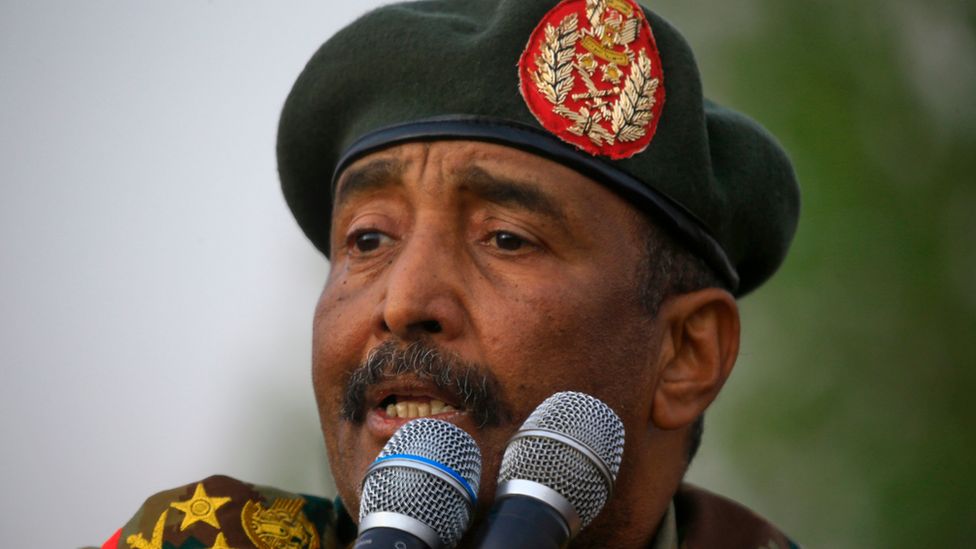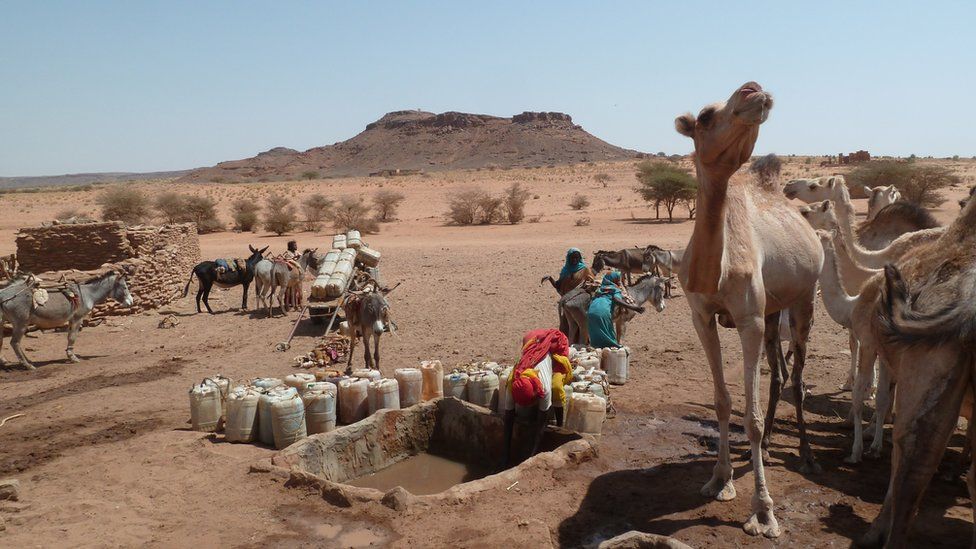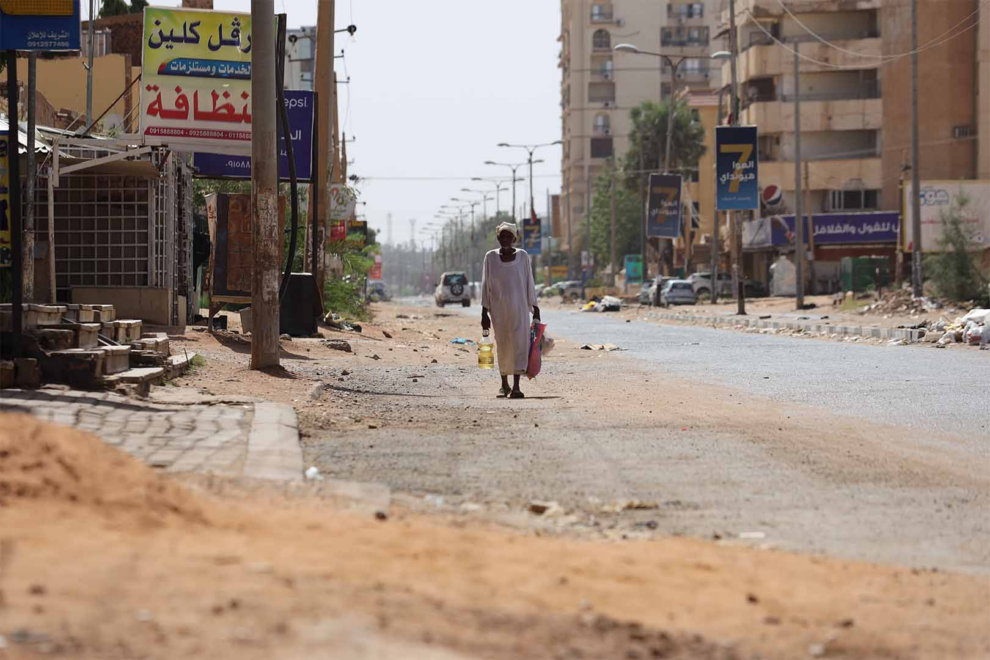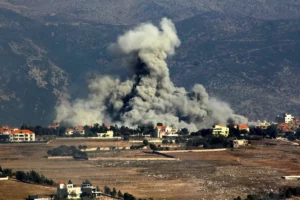Sudan’s history goes back to the pharaonic period. It was the largest and one of the most geographically diverse states in Africa, until its split into two countries in 2011 after southern Sudan voted for independence.
This followed decades of struggle by the mainly Christian and Animist south against rule by the Arab Muslim north.
Modern Sudan has long been beset by conflict and instability since independence, with two lengthy north-south civil wars and a protracted war in the western region of Darfur.
2023 saw fighting break out in the capital, Khartoum, as a result of a vicious power struggle within the country’s military leadership.
REPUBLIC OF THE SUDAN: FACTS
- Capital: Khartoum
- Area: 1,886,068 sq km
- Population: 47.9 million
- Languages: Arabic, English
- Life expectancy: 63 years (men) 68 years (women)
LEADER
Head of State: Lt-Gen Abdel Fattah al-Burhan

Lieutenant-General Abdel Fattah al-Burhan is the current military leader of Sudan. He took power after a military coup in April 2019 following months of protests against Omar al-Bashir’s government and his months authoritarian rule.
A military and civilian Sovereign Council was established to jointly rule Sudan and prepare the country for a return to civilian rule and national elections.
The military dismissed the civilian ministers in a coup in October 2021, but restored Prime Minister Abdalla Hamdok following a month of protests. Most civilian parties refused to support the new power-sharing deal.
Country-wide protests against Hamdok’s cooperation with the military led Hamdok to step down permanently in 2022. Al-Burhan has since pledged to establish a technocratic government and dismissed the five civilian members of council.
Lt-Gen Burhan has been accused of involvement in atrocities during military operations against non-Arab civilians in Darfur in 2003, when he was chief of ground forces.
MEDIA

Sudanese broadcasting is highly restricted and state TV and radio reflect government policy.
The private press carries opposition views, but the state uses its powers to influence what is published.
TIMELINE

Some key dates in Sudan’s history:
2500-1500BC – Kerma kingdom, based in the southern part of Nubia, present-day northern and central Sudan. It is finally absorbed into the New Kingdom of Egypt.
1550-1069BC – Much of Sudan is part of the New Kingdom of Egypt.
1070BC – 350AD – Following the late Bronze Age collapse of civilisations across the eastern Mediterranean, the Kingdom of Kush emerges as a Nubian state centred on the confluences of the Blue Nile and White Nile rivers.
350-1500 – Area sees sequence of medieval Christian kingdoms; Nobatia, Makuria, Alodia, and Daju.
639-641 – Muslim Arabs conquer Byzantine Egypt and then attempt to invade Nubia but are defeated.
14th and 15th Centuries – Bedouin tribes overrun most of Sudan.
1504-1821 – Sultanate of Sennar or Blue Sultanate, based in Sudan, north-western Eritrea and western Ethiopia.
1821 – Ottoman ruler of Egypt, Muhammad Ali of Egypt, conquers northern Sudan. Although technically under the Ottoman Empire, Muhammad Ali styles himself as Khedive of a virtually independent Egypt.
1881– Muhammad Ahmad, the Mahdi or Guided One, leads a successful war against Ottoman-Egyptian military rule in Sudan.
1884-85 – Siege of Khartoum. The British-appointed governor, General Gordon is killed when the city falls to Mahdist forces.
1885 – Muhammad Ahmad dies.
1890s – Britain seeks to re-establish their control over Sudan, nominally in the name of the Egyptian Khedive, but in reality as a British colony. Britain fears other colonial powers would take advantage of Sudan’s instability to acquire territory previously annexed to Egypt.
1896-98 – General Kitchener leads military campaigns, culminating in a decisive victory at the Battle of Omdurman in September 1898.
1899-1955 – Sudan is under joint British-Egyptian rule. In reality, Sudan is effectively administered as a British colony.
1952 – Egyptian revolution triggers a move towards Sudanese independence. Egypt and Britain allow both Sudanese regions, north and south, to vote on independence.
1956 – Sudan becomes independent.
1955-1972 – First Sudanese Civil War, between north and south over demands for more regional autonomy by southern Sudan region. Some 500,000 are estimated to have been killed. A 1972 peace agreement fails to satisfactorily dispel tensions.
1969 – Colonel Gaafar Nimeiry carries out a coup. Parliament and political parties are abolished.
1977 – Limited political pluralism introduced
1983 – Numeiry introduces Sharia Islamic law.
1983-2005 – Second Sudanese Civil War. Between the central Sudanese government and the Sudan People’s Liberation Army. Largely a continuation of the first civil war. The war leads to the independence of South Sudan in 2011. Some two million people die as a result of war, famine and disease caused by the conflict.
1989 – Colonel Omar al-Bashir carries out a military coup. Al-Bashir appoints himself president in 1993
2003-2020 – War in Darfur between the Sudan Liberation Movement (SLM) and the Justice and Equality Movement (JEM) rebel groups against the government, which they say is oppressing Darfur’s non-Arab population. The government responds with a campaign of ethnic cleansing against Darfur’s non-Arabs. The UN estimates up to 300,000 are killed in the fighting.
2009 – International Criminal Court issues an arrest warrant for President Bashir on charges of war crimes and crimes against humanity relating to the conflict in Darfur.
2011 – South Sudan gains independence following years of war with the central government in Khartoum.
2019 – Army ousts President Bashir after months of protests against his rule.
2020 – Sudan signs peace deal with the Sudan Revolutionary Front (SRF), a coalition of rebel groups from the western region of Darfur and the southern states of South Kordofan and Blue Nile, to end the fighting in Dafur.
2023 – Power struggle within the military government sees fighting break out between the regular army and members of the paramilitary Rapid Support Forces (RSF).
Source: bbc

















Add Comment